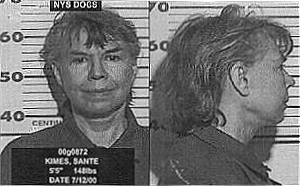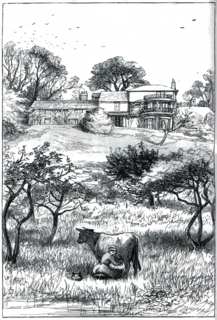
Forgery is a white-collar crime that generally refers to the false making or material alteration of a legal instrument with the specific intent to defraud anyone. Tampering with a certain legal instrument may be forbidden by law in some jurisdictions but such an offense is not related to forgery unless the tampered legal instrument was actually used in the course of the crime to defraud another person or entity. Copies, studio replicas, and reproductions are not considered forgeries, though they may later become forgeries through knowing and willful misrepresentations.

Norbiton is an area within the Royal Borough of Kingston upon Thames, London. It lies approximately 1 mile (1.6 km) east of Kingston upon Thames town centre, and 11 miles (17.7 km) from Charing Cross. Its main landmarks include Kingston Hospital, Kingsmeadow football stadium, Kingston Cemetery and St Peter's Anglican parish church which serves the area.

Sante Kimes was an American criminal who was convicted of two murders, as well as robbery, forgery, violation of anti-slavery laws, and numerous other crimes. Many of these crimes were committed with the assistance of her son, Kenny Kimes. They were tried and convicted together for the murder of Irene Silverman, along with 117 other charges.

William Henry Ireland (1775–1835) was an English forger of would-be Shakespearean documents and plays. He is less well known as a poet, writer of gothic novels and histories. Although he was apparently christened William-Henry, he was known as Samuel through much of his life, and many sources list his name as Samuel William Henry Ireland.
The salamander letter was a controversial document about the history of the Latter Day Saint movement that later proved to be a forgery.
Mark William Hofmann is an American counterfeiter, forger, and convicted murderer. Widely regarded as one of the most accomplished forgers in history, Hofmann is especially noted for his creation of documents related to the history of the Latter Day Saint movement. When his schemes began to unravel, he constructed bombs to murder three people in Salt Lake City, Utah. The first two bombs killed two people on October 15, 1985. On the following day, a third bomb exploded in Hofmann's car. He was arrested for the bombings three months later, and in 1987 pleaded guilty to two counts of second-degree murder, one count of theft by deception and one count of fraud.

Orley Farm is a novel written in the realist mode by Anthony Trollope (1815–82), and illustrated by the Pre-Raphaelite artist John Everett Millais (1829–96). It was first published in monthly shilling parts by the London publisher Chapman and Hall. Although this novel appeared to have undersold, Orley Farm became Trollope's personal favourite. George Orwell said the book contained "one of the most brilliant descriptions of a lawsuit in English fiction."

William Palmer, also known as the Rugeley Poisoner or the Prince of Poisoners, was an English doctor found guilty of murder in one of the most notorious cases of the 19th century. Charles Dickens called Palmer "the greatest villain that ever stood in the Old Bailey".
Mel Spillman is an American probate clerk and fraudster who transferred properties of dead people to his own accounts.
Uttering is a crime involving a person with the intent to defraud that knowingly sells, publishes or passes a forged or counterfeited document. More specifically, forgery creates a falsified document and uttering is the act of knowingly passing on or using the forged document.
Lambeth was a constituency 1832—1885 loosely equivalent in area to the later administrative units: the London Borough of Lambeth and the south-west and centre of the London Borough of Southwark. It returned two members of parliament (MPs) to the House of Commons of the UK Parliament by the bloc vote version of the first-past-the-post system.

Sir William Shee, QS was an Anglo-Irish politician, lawyer and judge, the first Roman Catholic judge to sit in England and Wales since the Reformation.
William Roupell was Liberal Party Member of Parliament of the United Kingdom for Lambeth from 1857 until his resignation on 4 February 1862. A forger and a fraudster, he was ruined in the Roupell case.
Frederick Doulton (1824–1872) was a British Liberal Party politician. He was Member of Parliament for Lambeth from 5 May 1862 until 1868.

The Ireland Shakespeare forgeries were a cause célèbre in 1790s London, when author and engraver Samuel Ireland announced the discovery of a treasure-trove of Shakespearean manuscripts by his son William Henry Ireland. Among them were the manuscripts of four plays, two of them previously unknown.
Sir Alexander Fitton (1630?–1698) sometimes known by his Jacobite title Baron Gawsworth, was an Irish barrister and judge, who became Lord Chancellor of Ireland, despite having spent many years in prison for criminal libel.
Ronald Tucker Finney was a convicted forger at the center of one of the biggest political scandals in Kansas history, known as the Kansas Bond Scandal, involving over $1 million in forged municipal bonds.

Theodosia, Lady Ivie or Ivy (1628–1697) was an aristocratic heiress and a figure of notoriety in the east end of London in the 17th century. Famed for her “wit, beauty and cunning in law above all others,” her claims to own land stretching from Wapping to Ratcliff led to a constant stream of litigation which ran for almost 75 years. At one particular trial, presided over by Lord Chief Justice Jeffreys, evidence emerged that Ivie had presented the court with forged deeds on which she made her land claims and Jeffreys subsequently arranged for charges to be brought against her for forgery.
Giwn Lloyd (1699–1774) of Hendwr and Tyfos, in the county of Merioneth and of Gwersyllt Park and Plas Newydd, in the county of Denbigh, was a Welsh gentleman who lived in the 18th century and was notorious for his dissolute life. He is best remembered for the lengthy court battle which ensued after his death, lasting over twenty years, exhausting the finances of many of his kinsmen, and shocking much of Welsh society.

Sherman Leland Whipple was an American attorney who was one of Boston's leading trial lawyers during his lifetime.